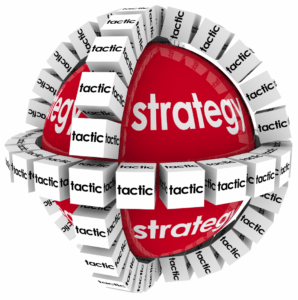“The term ‘strategy,’ much like ‘quality,’ is often overused and should be applied with precision. ‘The strategy’ should only be used unambiguously when it reflects a clearly defined and singular perspective.”
It’s important to carefully differentiate between the terms “the strategy,” “a strategy” (or “the strategies”), and “a strategic plan.” For a facilitator attuned to rhetorical precision, each of these terms carries distinct meanings. However, many people tend to use them interchangeably, often leading to confusion.
So, what distinguishes a strategic plan from a department plan, a product vision, a project plan, or a team plan? The primary difference lies in their scope. At its core, a “plan” can be succinctly defined in three words (or preferably five): “who does what” (by when). This basic principle of planning apply consistently across all levels of an organization.
Every business group needs answers to the nine questions listed in the “Strategic Planning Agenda”
- Mission (why are we here?)
- Values (who are we?)
- Vision (where are we going? how do we know if we get there or not?)
- Success Measures (what are our measurements of progress?)
- Current Situation (where are we now?)
- Actions (what should we do?—from strategy through tasks)
- Alignment (is this the right stuff to do?)
- Roles and Responsibilities (who does what, by when?)
- Communications Plan (what should we tell our stakeholders?
The term “strategy” within an organization or division often refers to a set of initiatives, typically organized as either a program or a portfolio. These initiatives consist of approved projects that receive investment funds and help further define the overarching goals. The program’s “strategy” is shaped by the quantity and type of projects within the portfolio. At the project level, “strategies” focus on the specific tactics needed to ensure the project’s success. Meanwhile, the team’s “strategy” involves the tasks and operations necessary to implement the project and support its ongoing operation and improvement.
The meaning of “strategy” is highly dependent on the perspective it serves. Referring to “the strategy” without clarifying its context provides only a partial understanding. To gain deeper insight into operational differences and to facilitate better alignment, consider the organizational holarchy and how each level contributes to the overall strategic framework.
______
Don’t ruin your career by hosting bad meetings. Sign up for a workshop or send this to someone who should. MGRUSH workshops focus on meeting design and practice. Each person practices tools and methods daily during the week. While some call this immersion, we call it the road that yields high-value facilitation skills.
Our workshops also provide a superb way to earn up to 40 SEUs from the Scrum Alliance, 40 CDUs from IIBA, 40 Continuous Learning Points (CLPs) based on Federal Acquisition Certification Continuous Professional Learning Requirements using Training and Education activities, 40 Professional Development Units (PDUs) from SAVE International, as well as 4.0 CEUs for other professions. (See workshop and Reference Manual descriptions for details.)
Want a free 10-minute break timer? Sign up for our once-monthly newsletter HERE and receive a free timer along with four other of our favorite facilitation tools.
Go to the Facilitation Training Store to access proven, in-house resources, including full agendas, break timers, forms, and templates. Also, take a moment to SHARE this article with others.
To Help You Unlock Your Facilitation Potential: Experience Results-Driven Training for Maximum Impact
#facilitationtraining #meeting design
______
With Bookmarks no longer a feature in WordPress, we need to append the following for your benefit and reference
- 20 Prioritization Techniques = https://foldingburritos.com/product-prioritization-techniques/
- Creativity Techniques = https://www.mycoted.com/Category:Creativity_Techniques
- Facilitation Training Calendar = https://mgrush.com/public-facilitation-training-calendar/
- Liberating Structures = http://www.liberatingstructures.com/ls-menu
- Management Methods = https://www.valuebasedmanagement.net
- Newseum = https://www.freedomforum.org/todaysfrontpages/
- People Search = https://pudding.cool/2019/05/people-map/
- Project Gutenberg = http://www.gutenberg.org/wiki/Main_Page
- Scrum Events Agendas = https://mgrush.com/blog/scrum-facilitation/
- Speed test = https://www.speedtest.net/result/8715401342
- Teleconference call = https://youtu.be/DYu_bGbZiiQ
- The Size of Space = https://neal.fun/size-of-space/
- Thiagi/ 400 ready-to-use training games = http://thiagi.net/archive/www/games.html
- Visualization methods = http://www.visual-literacy.org/periodic_table/periodic_table.html#
- Walking Gorilla = https://youtu.be/vJG698U2Mvo

Terrence Metz, MBA, CSM, CSPF, PSP01, HTTO1, is the Managing Director of MG RUSH Facilitation Leadership, Training, and Meeting Design, an acknowledged leader in structured facilitation training, and author of “Meetings That Get Results – A Facilitator’s Guide to Building Better Meetings.” His FAST Facilitation Best Practices blog features nearly 300 articles on facilitation skills and tools aimed at helping others lead meetings that produce clear and actionable results. His clients include Agilists, Scrum teams, program and project managers, senior officers, and the business analyst community among numerous private and public companies and global corporations. As an undergraduate of Northwestern University (Evanston, IL) and an MBA graduate from NWU’s Kellogg School of Management, his professional experience has focused on process improvement and product development. He continually aspires to make it easier for others to succeed.


